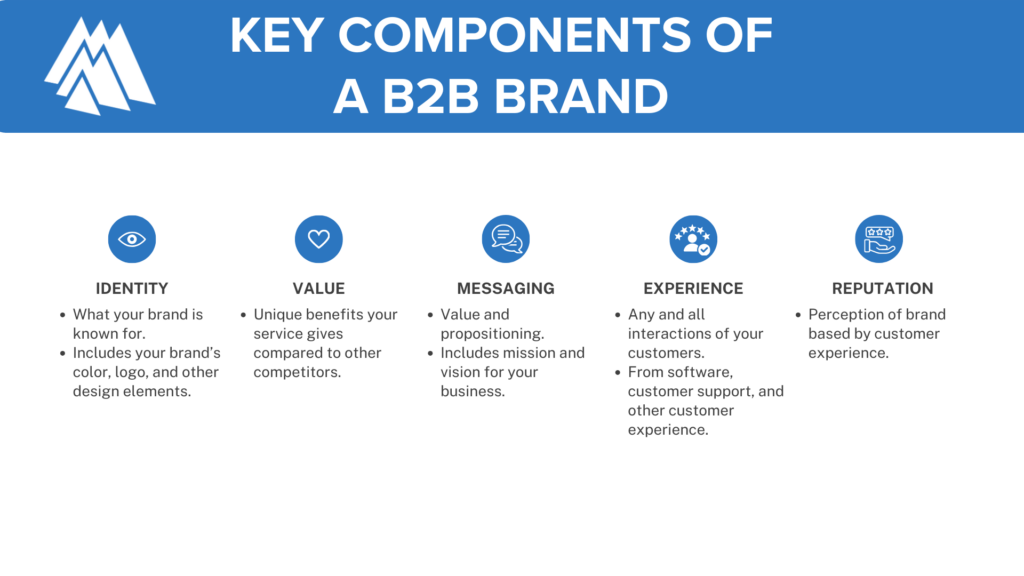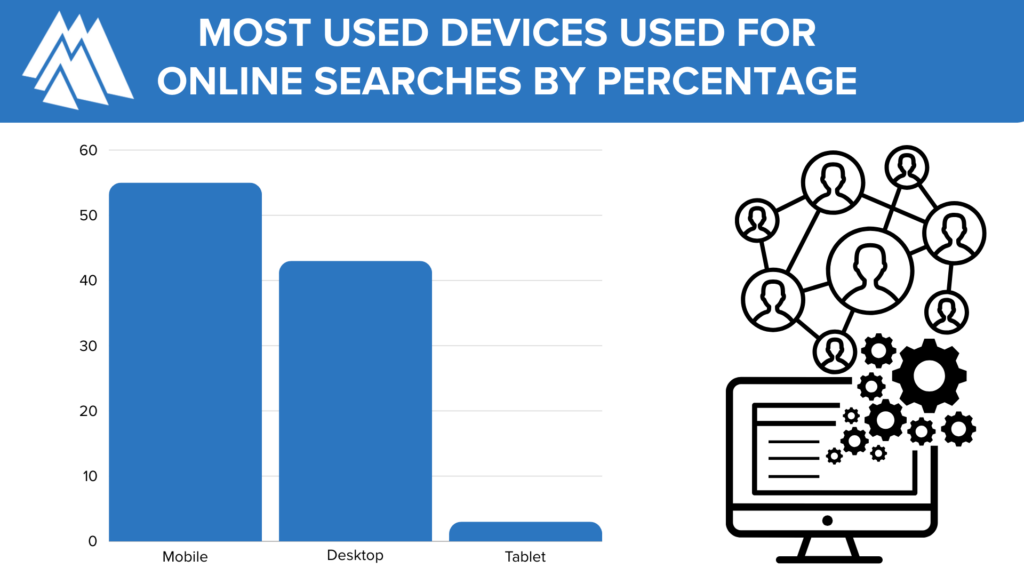The phrase “business-to-business” can be a bit of a misnomer. People still run businesses, which means a B2B’s brand still has to resonate with… People. That means the fundamentals of any great brand–even one that operates in a niche industry–are still the same. This guide aims to equip businesses with the knowledge and tools needed to create a distinctive brand, increase brand visibility, and improve productivity. With insights from real-world examples, you will be empowered to navigate the complexities of B2B branding and make a lasting impression in the minds of your target audience.

How to Build a B2B Brand That Stands Out: A Complete Guide
Understanding B2B Branding
B2B branding refers to the strategic process of creating and managing the identity, reputation, and perception of a business among other businesses or organizations within a specific industry or market segment. It involves crafting a distinct brand identity, value proposition, and messaging that resonates with the needs, priorities, and preferences of B2B customers. Unlike consumer-oriented branding, which targets individual consumers, B2B branding focuses on establishing credibility, trust, and perceived value to facilitate business-to-business transactions, partnerships, and long-term relationships.
Key Components of a B2B Brand

- Brand Identity: This includes visual elements such as the brand logo, color palette, typography, and design that convey the essence and personality of the brand.
- Value Proposition: The value proposition defines the unique benefits, solutions, or competitive advantages that the brand offers to its B2B customers, addressing their specific pain points, challenges, and business objectives.
- Brand Messaging: Consistent messaging across various communication channels helps reinforce the brand’s value proposition and positioning, communicating key messages that resonate with the target audience and differentiate the brand from competitors.
- Brand Experience: The overall experience that B2B customers have with the brand, including interactions with sales representatives, customer support, digital marketing touchpoints, and product/service delivery.
- Brand Reputation: The perception of the brand among its B2B audience, is shaped by factors such as the quality of products/services, customer service, thought leadership, and industry expertise.
Branding Phase 1: Market Research and Analysis
By conducting thorough market research and analysis, B2B companies can gain valuable insights into their target audience, industry preferences, and competitive positioning. This information serves as the foundation for developing effective marketing strategies, refining product offerings, and positioning the brand for success in the marketplace. Here are three fundamental steps to achieve a thorough foundation before brand building starts:
A. Identify Target Audience and Buyer Personas:
- Define Target Audience: Conduct research to identify the specific businesses, industries, or sectors that are most likely to benefit from your products or services.
- Create Buyer Personas: Develop detailed profiles of your ideal customers, including their demographics, job roles, pain points, goals, challenges, and buying behaviors.
- Gather Insights: Utilize surveys, interviews, and data analysis to gather insights into the needs, preferences, and behaviors of your target audience and buyer personas.
B. Analyze Industry Trends and Competitors:
- Industry Analysis: Research industry trends, market dynamics, and emerging technologies or innovations that may impact your target market.
- Competitive Analysis: Identify key competitors in your industry and analyze their strengths, weaknesses, market positioning, pricing strategies, product offerings, and marketing tactics.
- SWOT Analysis: Conduct a SWOT analysis (Strengths, Weaknesses, Opportunities, Threats) to assess your company’s competitive position relative to competitors and identify areas for differentiation and improvement.
C. Assess Brand Perception and Positioning in the Market:
- Brand Perception: Gather feedback from customers, partners, and industry experts to understand how your brand is perceived in the market. Assess brand awareness, reputation, trustworthiness, and perceived value.
- Positioning Analysis: Evaluate your brand’s positioning relative to competitors and determine whether it aligns with the needs and preferences of your target audience. Identify opportunities to differentiate your brand and carve out a unique value proposition in the market.
- Brand Audit: Conduct a comprehensive brand audit to assess brand assets, messaging consistency, visual identity, and overall brand coherence across various touchpoints.
Branding Phase 2: Building Awareness and Visibility
You’ve established your brand identity, with visual and verbal consistency. Now, you need to introduce it into the world. Here’s how:
A. Implement Targeted Advertising Campaigns:
- Define Objectives: Clearly outline the objectives of your advertising campaigns, whether it’s to increase brand awareness, generate leads, or drive conversions.
- Identify Target Audience: Use data and insights from market research to identify your target audience and tailor your advertising messages to resonate with their needs and preferences.
- Select Advertising Channels: Choose the most appropriate advertising channels to reach your target audience effectively, such as social media advertising, display ads, search engine optimization and search engine marketing (SEM), or industry-specific publications. Make sure that all advertising can be seen on multiple devices.
- Craft Compelling Ads: Develop creative and engaging ad content that communicates your brand message, value proposition, and key benefits. Use compelling visuals, persuasive copywriting, and clear calls-to-action (CTAs) to capture audience attention and drive action.
- Monitor and Optimize: Continuously monitor the performance of your advertising campaigns, track key metrics such as click-through rates (CTR), conversion rates, and return on investment (ROI), and optimize your campaigns based on data-driven insights to maximize effectiveness.
B. Participate in Industry Events and Conferences:
- Identify Relevant Events: Research industry events, conferences, trade shows, and networking opportunities that attract your target audience and align with your business marketing objectives.
- Plan Participation: Determine the level of participation that best suits your goals and budget, whether it’s exhibiting at a trade show, sponsoring an event, or attending as a speaker or panelist.
- Create an Engaging Activation: Design an engaging booth or exhibition space that reflects your brand identity and attracts attendees. Develop interactive demos, presentations, or activities to showcase your products/services and engage with potential customers.
- Network and Build Relationships: Take advantage of networking opportunities to connect with industry professionals, potential clients, and partners. Actively engage in conversations, exchange contact information, and follow up with leads after the event to nurture relationships.
- Measure ROI: Track the effectiveness of your participation in industry events by measuring metrics such as lead generation, brand exposure, and business opportunities generated.
Evaluate the ROI of each event and use insights to inform future event strategies.
Branding Phase 3: Measuring Performance
By measuring brand performance, B2B companies can gain valuable insights into the effectiveness of their branding efforts, identify areas for improvement, and make informed decisions to optimize brand strategy and drive business success. Here are tips for success:
A. Identify Key Performance Indicators (KPIs) for Brand Success:
- Brand Awareness: Measure the reach and recognition of your brand among your target audience through metrics such as brand recall, aided and unaided awareness, and social media mentions.
- Brand Engagement: Track engagement metrics to assess the level of interaction and involvement with your brand, including likes, shares, comments, and click-through rates on digital channels.
- Brand Perception: Conduct surveys or sentiment analysis to gauge how your target audience perceives your brand in terms of attributes such as trustworthiness, credibility, quality, and relevance.
- Customer Loyalty: Monitor customer retention rates, repeat purchase behavior, and Net Promoter Score (NPS) to measure the loyalty and advocacy of your existing customer base.
- Market Share: Assess your brand’s share of the market compared to competitors, both in terms of revenue and customer acquisition, to evaluate your competitive position and market penetration.
B. Implement Tools and Analytics to Track Brand Metrics:
- Use tools like Google Analytics to track website traffic, user behavior, and conversion rates, and gain insights into how visitors interact with your brand online.
- Leverage social media management platforms or native analytics tools to monitor engagement metrics, audience demographics, and sentiment analysis across social channels.
- Utilize brand monitoring tools to track mentions, reviews, and sentiments about your brand on social media, review websites, forums, and news outlets.
- Implement CRM systems to track customer interactions, preferences, and purchase history, and segment customers based on their engagement levels and lifetime value.
- Collect feedback from customers through surveys, polls, and feedback forms to gather qualitative insights into brand perception, satisfaction levels, and areas for improvement.
C. Evaluate Brand Performance and Making Adjustments as Needed:
- Regular Review: Schedule regular reviews of brand performance metrics to monitor progress toward goals, identify trends, and pinpoint areas of strength and weakness.
- Data Analysis: Analyze data collected from various sources to uncover insights, correlations, and patterns that inform strategic decision-making and optimization efforts. This elevates your brand positioning to potential customers.
- Benchmarking: Benchmark your brand performance against industry standards, competitors, and historical data to set realistic goals and benchmarks for improvement.
- Optimize: Use insights from performance evaluations to make data-driven adjustments and refinements to your brand strategy, messaging, positioning, and marketing tactics.
- Agility and Adaptation: Remain agile and responsive to changes in the market, customer preferences, and competitive landscape, and be prepared to pivot or iterate your brand strategy as needed to stay relevant and competitive.
Frequently Asked Questions
What is a B2B brand, and why is it important?
A B2B brand refers to the identity, reputation, and perception of a business within the business-to-business marketplace. It encompasses the values, messaging, and overall image that a company presents to other businesses. Building a strong B2B brand is crucial for differentiation, establishing trust, and creating lasting relationships with other businesses.
How can I define my B2B brand identity?
Defining your B2B brand identity involves understanding your company’s mission, values, target audience, and unique selling propositions. Conduct market research to gain insights into your audience’s needs, preferences, and pain points. Use this information to craft a distinct brand voice, messaging, and visual elements that resonate with your target audience.
What strategies can I use to differentiate my B2B brand from competitors?
To stand out in a crowded marketplace, focus on highlighting your unique value proposition and competitive advantages. Showcase your expertise, industry knowledge, and innovative solutions through thought leadership content, case studies, and testimonials. Emphasize the benefits of working with your company and how you solve specific challenges for your target audience.
Conclusion
Building a strong and distinctive B2B brand is not just a luxury but a necessity in today’s competitive marketplace. Investing in brand-building efforts is essential for businesses to differentiate themselves, establish credibility, and create lasting impressions with their target audience. By prioritizing brand building, businesses can position themselves for long-term success, drive customer loyalty, and unlock new opportunities for growth and expansion.




